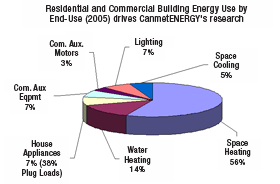Innovative technologies for the heating, ventilation, air conditioning and refrigeration (HVACR) of Canada’s homes and buildings (including commercial and recreational facilities), are required to enable us to meet the vision of market-feasible net-zero energy solutions by 2030 and to reduce electrical demand at peak times.
Energy demand in the approximately 450,000 commercial and institutional facilities across Canada grew by over 35% between 1990-2004, driven by increases in floor space and the use of auxiliary equipment. During the same period, the number of households in Canada increased to approximately 12 million dwellings, and house sizes rose. As a result the total energy consumption of the housing sector rose 10% representing a total annual energy bill of about $6 billion (2004).
The pursuit of efficiency gains in residential and commercial HVACR equipment and systems by the world-class experts at CanmetENERGY enables economic gains and reductions in greenhouse gases for Canadians.

[Click to enlarge]
Text version
Residential and Commercial Building Energy Use by End-Use (2005) drives CanmetENERGY’s research. Percentages are: Commercial Auxiliary Motors 3%, Lighting 7%, Space Cooling 5%, House Appliances 7% (38% of which is Plug Loads), Water Heating 14%, and Space Heating 56%.
Our areas of research innovation are driven by the impact our work can have on overall end use consumption, for example: integrated space, water and ventilation systems, high efficiency condensing commercial heating equipment, and micro-cogeneration systems (with overall efficiencies and greenhouse gas emissions (GHG) reduction potential 3 times lower than conventional central electricity generation plants). To address peak load issues we target demand management and load shifting through heat and electricity storage, controls, energy cascading and renewable energy technology integration. We actively engage in work on standards and regulation to ensure safe access to equipment for Canadians.
Our scientific experts have a long-standing reputation of collaborative R&D research, publishing and presenting the findings at international conferences.
For more information, visit our publication section or contact us.